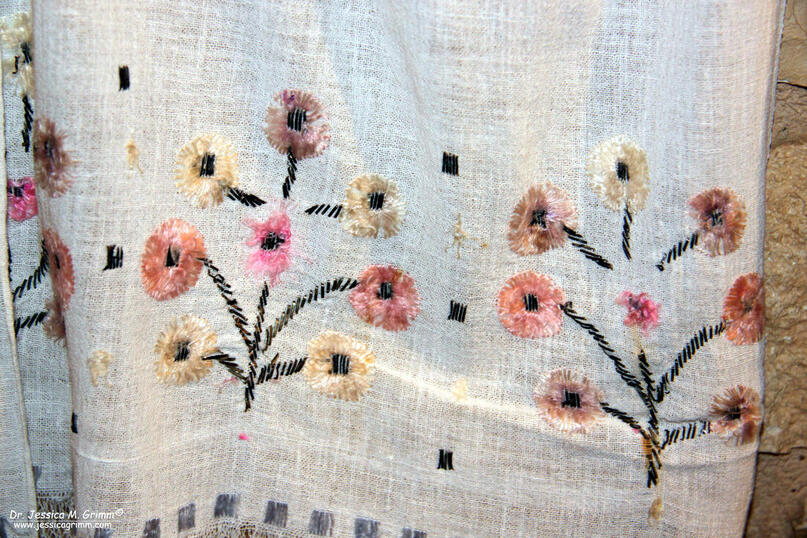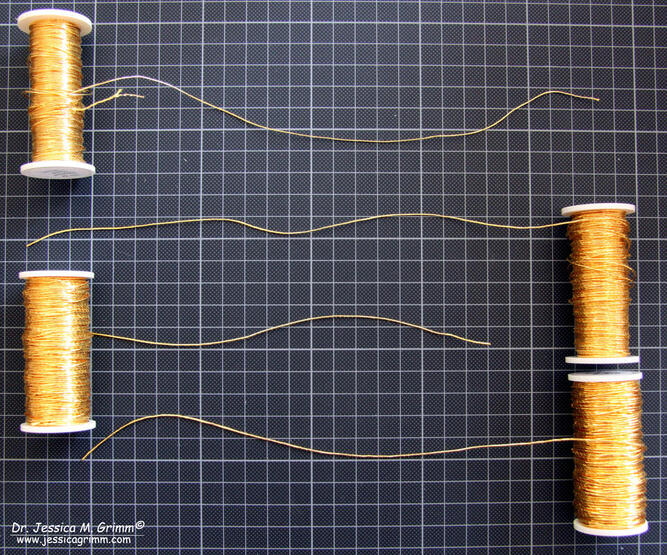|
Nowadays we have a plethora of different gold threads at our disposal. Or better: metal threads as they are available in a wide array of colours too. However, it all started much, much humbler thousands of years ago. Yep, that's how long these beauties have been around. The oldest mention of gold threads is in the bible (Exodus 39, 3): "They hammered the gold into thin plates and cut them into threads in order to work it into the blue, purple and scarlet yarn and the fine linen crafted by the skilled artisan." Personally, I think a link between the eruption of the volcano on ancient Thera and the story of Exodus is very plausible. New C-14 dating evidence showed that this eruption took place around 1613 BC +/- 13 years. Bear in mind that the book of Exodus existed as oral tradition for many generations before it was finally written down. However, it could mean that the manufacture of gold threads is at least nearly 4000 years old. What did these earliest gold threads look like? Well, if we read scripture carefully, it suggests to me that they looked a lot like our modern plate. Thin strips of flat metal thread. On the other hand, the fact that they are "worked into the blue, purple and scarlet yarn" sounds a bit like it is being used as blending filament. Now modern-day blending filament is a super-thin polyester. Certainly not what the ancient Hebrews had at their disposal. Their thread must have been stiffer, heavier and thicker. But it might just be that they used it in a similar way as modern embroiderers use blending filament. Or they used the thin strips of metal just like the embroiderers in Turkey. They take a large flat needle and use lengths of plate IN the needle. Not like the way I was thought to use plate at the Royal School of Needlework where we couched it down. A disadvantage of used hammered precious metals as a base for your gold threads is that they are very expensive. Furthermore, when you work them into the garment, that garment becomes quite heavy. To overcome the first problem, gilt threads were introduced. This means that you use a more base metal such as silver or copper and you adhere a very thin layer of gold to it. This reduces the cost. But you are still left with the weight issue. In comes the invention of hammering the metal into even tinner sheets, cutting them into strips and adhering these strips onto animal gut or plant material such as mulberry paper. The combined material is then wrapped around a yarn core by means of spinning. These threads would have been comparable to today's Japanese Threads. When and where were these new metal threads invented? Unfortunately, the exact origin and time are unknown, but a pure gold strip likely wound around a fibrous core (not survived as it was a cremation) has been found in a Roman grave of a young woman in Cadiz, Spain. The tiny dimensions of the gold strip are mind-boggling: 0.2 mm wide and only 3.6 microns thick. There is a second method for producing metal threads: wire drawing. By passing a strip of metal through a progressivly smaller series of holes, very fine metal wire could be obtained. These were probably first used in jewellery production, but archaeological finds show that they were also used in textile production in China from the 2nd century BC and in the port of trade Birka (Sweden) from the 9/10th century. Some of these threads consist of tightly wound wires around a textile core. Although some researchers suggest that these wires were actually imported from the East (Byzantium) it is noteworthy that these kinds of wires have been known to the Sami people. However, they use pewter and not silver or gold. I wrote a blog article on their type of embroidery. These threads look like very fine pearl purl, but with a fibrous core. They are still produced today and can be obtained online from Swedish webshops. Gilded silver threads began to appear in the 9th century, but might be older. The oldest type consists of hammered sheets of silver covered with a thin layer of gold. When strips are cut from these sheets, they are gilded on only one side. These strips were then spun around a fibrous core. This type of gold thread is known as or de Milan. Were they invented in Milan or simply traded from Milan into the rest of Europe? These threads further developed in the 16th century as gilded drawn silver threads were hammered flat and spun around a fibrous core. These threads are all-over golden. These drawn threads have the huge advantage that they are much longer than the strips from the sheets and thus reduce the number of joints whilst spinning. This is in essence a passing thread. And then there is yet another method to produce a gold thread with a fibrous core: membrane gold. This is where animal tissue is gilded and then cut into strips which are then spun around a fibrous core. This method was likely invented in the 11th century and was both a much cheaper way to produce gold threads and it reduced the weight considerably. These threads were hugely popular and used in great quantities. These threads are commonly called Cypriot gold. However, new research by David Jacoby suggests that this is a misnomer. Furthermore, historical documents suggest that this type of thread was not at all cheap. Jacoby pushes for further research into the compositions of the alloys of the surviving gold threads as well as the identification of their cores and animal tissues to identify their origins. This would indeed make for exciting research and answer many questions regarding the how, where and when. If you are interested in the topic, do click the links for the Jacoby and Katzani papers as they make for interesting and detailed reading. They also provide lots of further papers in their references. Sources:
Friedrich W. L., et al., (2006): Santorini eruption radiocarbon dated to 1627–1600 BC., Science 312, p. 548–548. Jacoby, D., (2014): Cypriot Gold Thread in Late Medieval Silk Weaving and Embroidery. In: S. B. Edgington and H. J. Nicholson (eds), Deeds Done Beyond the Sea: Essays on William of Tyre, Cyprus and the gate Military Orders, p. 101-114. Karatzani, A., (2014): Metal thread: the historical development. Keynote lecture at the conference "Traditional Textile Craft - An Intangible Cultural Heritage?", The Jordan Museum, Amman. Stern, D.H., (1998): Complete Jewish Bible. Jewish New Testament Publications.
9 Comments
There was also gold thread found in the coffin of the Spitalfields Roman Lady in London. If memory serves it seemed likely to be metal wrapped around a silk or linen core, but off-hand I don't remember the dating.. <pause>
Reply
21/10/2019 18:08:25
Thanks for that Rachel! Yes, the young lady in Cadiz was Augustan in date.
Reply
Monica
21/10/2019 21:11:13
Hi Jessica, very interesting blog!
Reply
21/10/2019 21:55:59
Thank you Monica! Yes, the technologies are available and it might well be that research has actually started. However, since I don't have access to 'fresh' academic journals, that's rather hard for me to find out. Don't you hate the fact that access to these journals is so expensive?
Reply
Irene
23/10/2019 21:41:13
Interesting post. Thank you.
Reply
23/10/2019 22:35:08
Thank you Irene! Yes, I do. I use Citavi to order my references and it automatically searches the internet for free copies of a particular paper. Furthermore, I use Academia to get my hands on papers that members have uploaded. I can also access many recent journals through the Bavarian State Library. However, I need to travel to Munich to actually read them as online access is limited to the greater Munich area :(.
Reply
A very interesting post, thank Jessica! And quite timely for me personally too as I have just returned home from an intensive study of metalwork and the history of the threads and technique. All very interesting, especially to see how the embroiderers through the centuries have used what they have available to them at that point in time.
Reply
26/10/2019 13:15:53
Your study time sounds very interesting too! Will you blog about it?
Reply
Your comment will be posted after it is approved.
Leave a Reply. |
Want to keep up with my embroidery adventures? Sign up for my weekly Newsletter to get notified of new blogs, courses and workshops!
Liked my blog? Please consider making a donation or becoming a Patron so that I can keep up the good work and my blog ad-free!
Categories
All
Archives
July 2024
|
Contact: info(at)jessicagrimm.com
Copyright Dr Jessica M. Grimm - Mandlweg 3, 82488 Ettal, Deutschland - +49(0)8822 2782219 (Monday, Tuesday, Friday & Saturday 9.00-17.00 CET)
Impressum - Legal Notice - Datenschutzerklärung - Privacy Policy - Webshop ABG - Widerrufsrecht - Disclaimer
Copyright Dr Jessica M. Grimm - Mandlweg 3, 82488 Ettal, Deutschland - +49(0)8822 2782219 (Monday, Tuesday, Friday & Saturday 9.00-17.00 CET)
Impressum - Legal Notice - Datenschutzerklärung - Privacy Policy - Webshop ABG - Widerrufsrecht - Disclaimer








 RSS Feed
RSS Feed